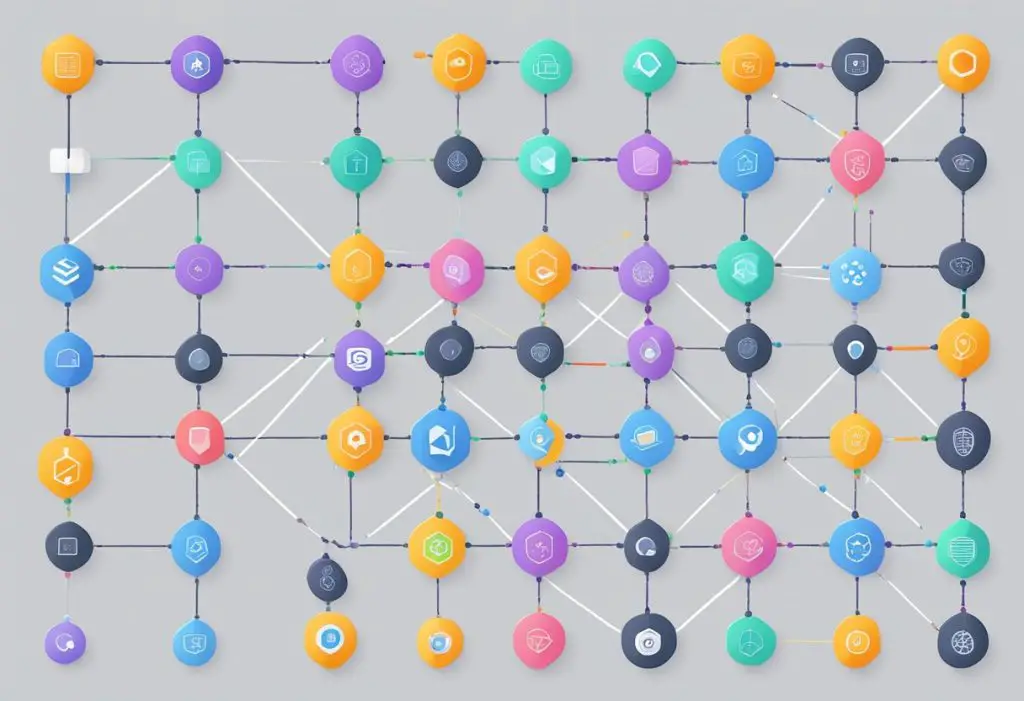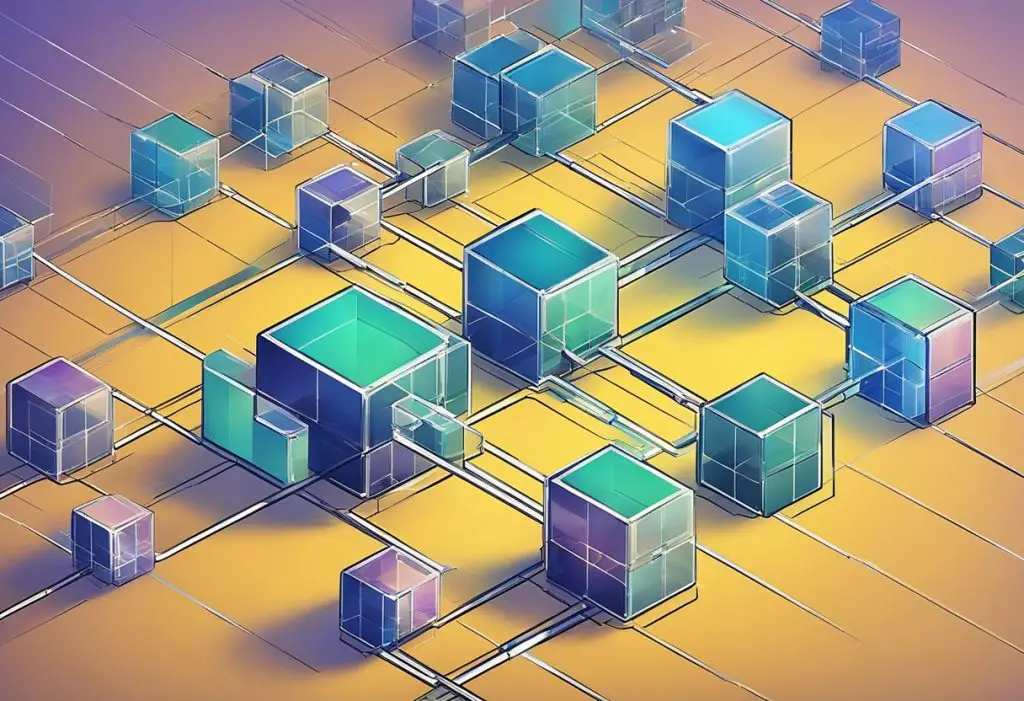Table of Contents
Introduction to How Blockchain Works
Blockchain technology has been gaining popularity in recent years as a secure and efficient way to store and transfer data. At its core, blockchain is a decentralized, distributed ledger that records transactions and stores data in blocks linked together via cryptography. This means that there is no central authority controlling the data, and each block is verified by multiple nodes on the network, making it virtually impossible to tamper with.
The fundamentals of blockchain technology are based on three key concepts: decentralization, transparency, and security. Because there is no central authority controlling the data, blockchain is considered to be a decentralized technology. This means that the data is stored on a distributed network of nodes, rather than on a single server or database. The transparency of blockchain comes from the fact that all transactions are recorded on a public ledger that can be viewed by anyone with access to the network. Finally, the security of blockchain is maintained through the use of cryptographic algorithms that ensure that each block is linked to the previous one, making it extremely difficult to alter or tamper with the data.
Key Takeaways:
- Blockchain is a decentralized, distributed ledger that stores data in blocks linked together via cryptography.
- The fundamentals of blockchain technology are based on decentralization, transparency, and security.
- Blockchain is being used for various purposes, such as cryptocurrency systems, decentralized finance, non-fungible tokens, and smart contracts.
Fundamentals of Blockchain Technology

How Blockchain Works Image 1
Defining How Blockchain Works and Its Purpose
Blockchain technology is a digital ledger that records transactions in a secure and immutable way. It is a distributed ledger technology that enables multiple parties to have access to the same information, without the need for a central authority. The purpose of blockchain technology is to provide a decentralized, transparent, and secure way of recording and transferring digital assets.
The Structure of a Block
A block is the basic unit of information in a blockchain. It contains a list of transactions, a timestamp, and a unique digital signature called a hash. The hash is generated using a cryptographic algorithm that ensures the integrity of the block. Once a block is added to the chain, it becomes immutable, meaning that it cannot be altered or deleted.
Understanding Distributed Ledger Technology
Distributed ledger technology is the underlying technology behind blockchain. It is a decentralized database that enables multiple parties to have access to the same information, without the need for a central authority. Each node in the network has a copy of the ledger, and any changes made to the ledger are verified by the network before they are added to the chain.
The distributed nature of the ledger makes it highly secure, as there is no single point of failure. In addition, the use of cryptographic algorithms ensures that the information stored on the ledger is tamper-proof and cannot be altered or deleted.
In conclusion, blockchain technology is a revolutionary technology that has the potential to transform the way we store and transfer digital assets. Its decentralized and secure nature makes it highly attractive to a wide range of industries, from finance and banking to healthcare and logistics. By understanding the fundamentals of blockchain technology, we can better appreciate its potential and explore new ways of using it to solve real-world problems.
How Transactions are Processed

How Blockchain Works Image 2
When a transaction is made on a blockchain, it needs to be processed and verified by the network before it can be added to the blockchain. This is done through a series of steps that involve transaction data and recording, cryptographic hashes and security, and the role of consensus algorithms.
Transaction Data and Recording
A blockchain transaction is initiated when someone transfers a digital asset they own to another person. The transaction includes the amount, the destination of the funds, and a signature to prove its authenticity. This information is then recorded on the blockchain as a block.
Cryptographic Hashes and Security
To ensure the security of the transaction data, blockchain uses cryptographic hashes. A hash is a digital signature of sorts that is unique to the data being hashed. This means that any changes to the data will result in a different hash. By using hashes, blockchain ensures that the data recorded on the blockchain is tamper-proof.
The Role of Consensus Algorithms
Once a transaction is recorded on the blockchain, it needs to be verified by the network. This is done through consensus algorithms. Consensus algorithms are a set of rules that determine how transactions are verified and added to the blockchain. Miners or validators, depending on the type of blockchain, are responsible for verifying transactions and adding them to the blockchain.
In conclusion, the processing of blockchain transactions involves a series of steps that ensure the security and integrity of the data being recorded on the blockchain. By using cryptographic hashes and consensus algorithms, blockchain ensures that transactions are verified and added to the blockchain in a secure and efficient manner.
Different Types of Blockchains

How Blockchain Works Image 3
Blockchain technology can be categorized into several types, each with its unique features and applications. The following are the main types of blockchain:
Public vs. Private Blockchains
Public blockchains allow anyone to join and participate in the network without any restrictions. These networks are entirely decentralized, and all transactions and data are visible to everyone on the network. Bitcoin and Ethereum are some of the most popular public blockchains.
On the other hand, private blockchains are permissioned networks that require users to have access granted by the network administrator. These networks are ideal for businesses and organizations that require a high level of privacy and security. Private blockchains are often used in industries such as finance, healthcare, and government.
Consortium and Hybrid Blockchains
Consortium blockchains are a mix of public and private blockchains. They allow a group of organizations to share a blockchain network while maintaining control over their data and transactions. Consortium blockchains are ideal for industries such as supply chain management, where multiple organizations need to share data and collaborate.
Hybrid blockchains, on the other hand, are a combination of public and private blockchains. They offer the benefits of both types of blockchains, such as transparency and security. Hybrid blockchains are often used in industries such as media, where content creators need to protect their intellectual property while ensuring transparency in revenue sharing.
Blockchain in Various Industries
Blockchain technology has the potential to revolutionize various industries, including government, healthcare, and supply chain management. In government, blockchain can be used to improve transparency and accountability in voting systems and public records. In healthcare, it can be used to improve patient data management and secure medical records. In supply chain management, blockchain can be used to track products from the manufacturer to the end consumer, improving transparency and reducing the risk of fraud.
In conclusion, blockchain technology offers a wide range of benefits and applications across various industries. Understanding the different types of blockchains is crucial in choosing the right solution for your business or organization.
Blockchain’s Impact and Future Applications

How Blockchain Works Image 4
Blockchain technology has the potential to revolutionize various industries and transform the way transactions are conducted. Here are some of the potential future applications of blockchain technology:
Decentralized Applications and Finance
One of the most significant impacts of blockchain technology is on decentralized applications and finance. The introduction of smart contracts has enabled the creation of decentralized applications that run on a blockchain network. Ethereum is one of the most popular blockchain platforms that allow developers to build decentralized applications.
Decentralized finance (DeFi) is another application of blockchain technology that has gained popularity in recent years. DeFi refers to a financial system built on a decentralized blockchain network, where users can lend, borrow, and trade cryptocurrencies without the need for intermediaries.
Blockchain in Identity Verification and Intellectual Property
Blockchain technology has the potential to revolutionize the way identity verification is conducted. With a blockchain-based identity verification system, users can have complete control over their personal data and share it with only the entities they trust.
Another potential application of blockchain technology is in the area of intellectual property. Blockchain-based systems can enable the creation of immutable records of ownership, which can help prevent piracy and counterfeiting.
Challenges and Considerations for Adoption
While blockchain technology presents new opportunities, it also comes with its own set of challenges and considerations. One of the significant challenges is the risk associated with the use of smart contracts. Smart contracts are self-executing contracts that automatically enforce the terms of an agreement. However, if there are bugs in the code, it can lead to significant losses.
Another consideration for the adoption of blockchain technology is the issue of scalability. Blockchain networks currently have limited capacity, which can lead to slow transaction times and high transaction fees.
Despite these challenges, the potential benefits of blockchain technology are significant. As the technology continues to evolve, it is likely that we will see new and innovative applications emerge, transforming industries and the way we conduct transactions.
Frequently Asked Questions

How Blockchain Works Image 5
What are the basic steps involved in a blockchain transaction?
A blockchain transaction typically involves the following basic steps:
- A transaction is initiated by a user.
- The transaction is verified by a network of computers (nodes) on the blockchain.
- Once verified, the transaction is added to a block.
- The block is then added to the blockchain, which is a permanent, unalterable record of all transactions.
Can you provide a simple explanation of what blockchain is?
Blockchain is a decentralized, digital ledger that records transactions across a network of computers. Each block in the blockchain contains a cryptographic hash of the previous block, a timestamp, and transaction data. Once a block is added to the blockchain, it cannot be altered or deleted.
What are some common examples of blockchain technology in use today?
Blockchain technology is being used in a variety of industries, including finance, healthcare, and supply chain management. Some common examples of blockchain technology in use today include:
- Cryptocurrencies such as Bitcoin and Ethereum
- Supply chain management systems that use blockchain to track products from manufacturer to consumer
- Healthcare systems that use blockchain to securely store and share patient data
What are the different types of blockchain networks available?
There are three main types of blockchain networks: public, private, and consortium. Public blockchains, such as Bitcoin and Ethereum, are open to anyone and allow anyone to participate in the network. Private blockchains are only accessible to authorized participants and are often used by businesses and organizations for internal purposes. Consortium blockchains are controlled by a group of organizations and are typically used for collaborative efforts.
How can blockchain platforms generate revenue?
Blockchain platforms can generate revenue in a variety of ways, including:
- Transaction fees for processing transactions on the blockchain
- Selling tokens or cryptocurrencies associated with the platform
- Providing services such as smart contract development or consulting
Could you recommend a beginner-friendly guide to understanding blockchain?
There are many beginner-friendly guides to understanding blockchain available online. One popular resource is the Blockchain Basics course offered by the Blockchain Council. This course covers the basics of blockchain technology, including how it works, its history, and its potential applications.

